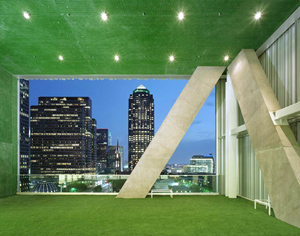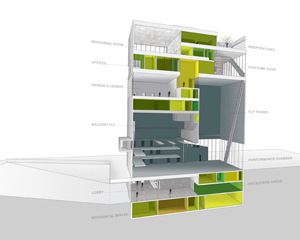 |
 |
 |
 |
 |
 |
| |
 |
|
 |
 |
 |
  |
  |
 |
 |
 |
 |
|
|
 |
|
 |
 |
 |
BUILDING |
 |
|
 |
|
 |
 |
 |
| |
 |
| 
 |
Dee and Charles Wyly Theatre
|
|
 |
 |
 |
 |
DESIGNER |
 |
|
|
 |
|
 |
 |
 |
| |
 |
|
 |
 |
 |
 |
DESCRIPTION |
 |
|
|
 |
|
 |
 |
 |
| . |
 |
|
 |
 In the typical theater, the proliferation of front-of-house and back-of-house spaces threatens to strangle the auditorium itself, buffering the performance from the outside world. The compact, vertical orientation of the Wyly Theatre, with its 11 storeys, allows support spaces to be stacked above and beneath the auditorium rather than wrapped around it. In the typical theater, the proliferation of front-of-house and back-of-house spaces threatens to strangle the auditorium itself, buffering the performance from the outside world. The compact, vertical orientation of the Wyly Theatre, with its 11 storeys, allows support spaces to be stacked above and beneath the auditorium rather than wrapped around it.
 No longer shielded by transitional and technical areas – foyer, ticket counters, backstage facilities – this reimagining of the theatre typology exposes the auditorium to the city on all sides. On alternate nights, the Dallas Theatre Center, for whom the Wyly will be a new home, can perform Shakespeare in a hermetic container one night, or – opening the blackout blinds along the exterior glass walls – with the city of Dallas as a backdrop the next. No longer shielded by transitional and technical areas – foyer, ticket counters, backstage facilities – this reimagining of the theatre typology exposes the auditorium to the city on all sides. On alternate nights, the Dallas Theatre Center, for whom the Wyly will be a new home, can perform Shakespeare in a hermetic container one night, or – opening the blackout blinds along the exterior glass walls – with the city of Dallas as a backdrop the next.
The tallness and simplicity of the box form, together with the unique visibility of the activities in the theatre, gives the building prominence in the large new complex of the Dallas Center for the Performing Arts. The form also facilitates innovation in the theatre’s mechanics: the conventional fly tower above the stage has been extended vertically (with program concentrated around it on multiple levels), and can pull up both scenery and seating. This allows artistic directors to rapidly change the venue into a wide array of configurations that push the limits of the ‘multi-form’ theatre: proscenium, thrust, traverse, arena, studio, and flat floor – in which the seating, and the balconies, can be removed entirely. The stage and the floor of the auditorium are deliberately made of non-precious materials – the floor can be drilled, nailed into, and painted at will. In this way, together with the easily manipulable seating and stage configuration, the Wyly Theatre seeks to preserve and elaborate the flexible, improvisatory nature of the Dallas Theatre Center's original home. |
|
 |
 |
 |
 |
 |
 |
 |
LOCATION |
 |
|
|
 |
|
 |
 |
 |

|
 |

|
Continent |
|
 |
  North America |
|
Nation |
|
 |
  United States |
|
State |
|
 |
  Texas |
|
County |
|
 |
  Dallas |
|
Town |
|
 |
  Dallas |
|
Address |
|
 |
  Flora St., Leonard St., Jack Evans St. (Arts District)
|
|
|
|
 |
|
Website |
|
 |
|
 |
 |
 |
 |
MAP |
 |
|
|
 |
|
 |
 |
 |
| |
 |
|
 |
 |
 |
 |
|
TYPOLOGY |
 |
|
|
 |
|
 |
 |
 |
Main |
 |
|
 |
ARCHITECTURE | Buildings for recreational activities
Theatres
| |
|
|
 |
|
Additional |
 |
|
 |
ARCHITECTURE | Buildings for offices and professional practises
Offices
Commercial buildings
Bars, cafeterias
Buildings for recreational activities
Auditoriums and music centres
| |
 |
 |
 |
 |
CHRONOLOGY |
 |
|
|
 |
|
 |
 |
 |
Project |
 |
|
 |
| 
 |
2004
|
|
Realisation |
 |
|
 |
| 
 |
2006 - 2009 |
|
 |
 |
 |
 |
BIBILIOGRAPHIC REFERENCES |
 |
|
|
 |
|
 |
 |
 |
|
 |
| Dietmar Fröhlich, , "Vertikaler Antipode", Architektur Aktuell 358-359, januar-februar/january-february 2010 [Treibstoff Kultur / Spaces of Beauty], pp. 64-75 |
|
|
| David Dillon, "Chill between Koolhaas [theatre] and Foster [opera house] could hurt Dallas project", Architectural Record 5/2005, may 2005, p. 54 |
|
|
| "Arte e spettacolo a Dallas/New Arts District", L'Arca 196, ottobre/october 2004, "l'Arca2" p. 90 |
|
|
| David Dillon, "Dallas unveils designs for performing arts center", Architectural Record, 7/2004, july 2004, p. 24 |
|
 |
 |
 |
 |
 |
 |
 |
CLIENT |
 |
|
|
 |
|
 |
 |
 |
| |
 |
| Dallas Center for the Performing Arts |
|
 |
 |
 |
 |
DIMENSIONAL
DATA |
 |
|
|
 |
|
 |
 |
 |
| Capacity |
 |
|
 |
|
| Surface |
 |
|
 |
|
 |
 |
 |
 |
STRUCTURES |
 |
|
|
 |
|
 |
 |
 |
| |
 |
| Magnusson Klemencic Associates |
|
 |
 |
 |
 |
STAFF |
 |
|
|
 |
|
 |
 |
 |
|
 |
|
Project leader |
 |
Joshua Prince-Ramus (REX)
Rem Koolhaas (OMA) |
|
Project architect |
 |
| Erez Ella, Vincent Bandy, Tim Archambault, Vanessa Kassabian |
|
Design team |
 |
| Haviland Argo, Steve Chen, Dan Choi, Robert Donnelly, Selva Gurdogan, Jonathan Handel, Stine Hansen, Oke Hauser, Andrew Heid, Nahyun Hwang, Ashley Klein, Trine Kobbelvedt, Natalia Ibanez Lario, Soren Sigurd Larsen, Mads Kristensen, Filip Rem, Beatriz Ramo, Gro Sarauw, Max Schwitalla, Rooshad Shroff, Gregers Tang Thomsen, Lisa Tiedje, Angelica Trevino, Kristine Wander, Monika Wittig, Dolly Yarur |
|
Executive architect |
 |
Kendall / Heaton Associates
Rex Wooldridge, Pat Ankney, Vince Nguyen, Matt Upchurch |
|
Structural consultant |
 |
Magnusson Klemencic Associates
Jay Taylor, Owen Kohashi, Lavina Sadhwani |
|
Acoustical consultant |
 |
DHV
Renz van Luxemburg, Ben Kok, Theo Raijmakers |
|
Furniture |
 |
Quinze & Milan
Arne Quinze, Tom DeGres, Alain Gilles |
|
Graphic design |
 |
2x4
Michael Rock, Albert Lee |
|
Lighting engineer |
 |
Tillotson Design Associates
Suzan Tillotson, Christopher Cheap |
|
Theatre consultant |
 |
Theatre Projects Consultants
John Coyne, Benton Delinger, John Runia, David Taylor |
|
Mechanical engineer |
 |
Transsolar / Cosentini / Plus Group
Stefan Holst, Igor Bienstock, Mark Malekshahi, Peter Lee |
|
Vertical transportation |
 |
|
Quantity surveyor |
 |
Donnell Consultants Inc.
Stewart Donnell, Athol Joffe, Steve Ryan Donnell Consultants Inc. Stewart Donnell, Athol Joffe, Steve Ryan |
|
Developer |
 |
McCarthy Construction
Gary Akin, Wayne Hendricks |
|
 |
 |
 |
 |
CREDITS |
 |
|
|
 |
|
 |
 |
 |
| |
 |
Photos © Iwan Baan, Tim Hursley
Drawings © OMA / REX
Text edited by OMA / REX
Courtesy of OMA / REX
|
|
 |
  |
 |
|
|